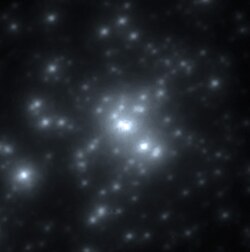R136b
| Observation data Epoch J2000.0 Equinox J2000.0 (ICRS) | |
|---|---|
| Constellation | Dorado |
| Right ascension | 05h 38m 42.74s[1] |
| Declination | −69° 06′ 03.78″[1] |
| Apparent magnitude (V) | 13.24[1] |
| Characteristics | |
| Spectral type | O4If[2] |
| B−V color index | −0.18[1] |
| Astrometry | |
| Distance | 163,000 ly (49,970[3] pc) |
| Absolute magnitude (MV) | −7.75[2] |
| Details[2] | |
| Mass | 117+91 −51 M☉ |
| Radius | 40.0 R☉ |
| Luminosity | 2,188,000 L☉ |
| Surface gravity (log g) | 3.30±0.25 cgs |
| Temperature | 35,000±2,500 K |
| Rotational velocity (v sin i) | 85 km/s |
| Age | 1.7±0.2 Myr |
| Other designations | |
| Database references | |
| SIMBAD | data |
R136b is a blue supergiant star in the R136 cluster in the Large Magellanic Cloud. It is one of the most massive and most luminous stars known. It is found in the dense R136 open cluster at the centre of NGC 2070 in the Tarantula Nebula.
R136b has the spectral type of Wolf–Rayet star, with strong emission lines.[4] Although it shows enhanced helium and nitrogen at its surface, it is still a very young star, still burning hydrogen in its core via the CNO cycle, and still effectively a main sequence object.[5] Others studies classify the spectrum as a hot supergiant with emission lines of ionised nitrogen and helium, still considering it to be a young star at the core-hydrogen-burning stage, the unusual spectrum caused by strong convection and stellar winds.[2]
References[edit]
- ^ a b c d Doran, E. I.; Crowther, P. A.; De Koter, A.; Evans, C. J.; McEvoy, C.; Walborn, N. R.; Bastian, N.; Bestenlehner, J. M.; Gräfener, G.; Herrero, A.; Köhler, K.; Maíz Apellániz, J.; Najarro, F.; Puls, J.; Sana, H.; Schneider, F. R. N.; Taylor, W. D.; Van Loon, J. Th.; Vink, J. S. (2013). "The VLT-FLAMES Tarantula Survey. XI. A census of the hot luminous stars and their feedback in 30 Doradus". Astronomy & Astrophysics. 558: A134. arXiv:1308.3412. Bibcode:2013A&A...558A.134D. doi:10.1051/0004-6361/201321824. S2CID 118510909.
- ^ a b c d Bestenlehner, Joachim M.; Crowther, Paul A.; Caballero-Nieves, Saida M.; Schneider, Fabian R. N.; Simón-Díaz, Sergio; Brands, Sarah A.; De Koter, Alex; Gräfener, Götz; Herrero, Artemio; Langer, Norbert; Lennon, Daniel J.; Maíz Apellániz, Jesus; Puls, Joachim; Vink, Jorick S. (2020). "The R136 star cluster dissected with Hubble Space Telescope/STIS. II. Physical properties of the most massive stars in R136". Monthly Notices of the Royal Astronomical Society. 499 (2): 1918. arXiv:2009.05136. Bibcode:2020MNRAS.499.1918B. doi:10.1093/mnras/staa2801.
- ^ Pietrzyński, G; D. Graczyk; W. Gieren; I. B. Thompson; B. Pilecki; A. Udalski; I. Soszyński; et al. (7 March 2013). "An eclipsing-binary distance to the Large Magellanic Cloud accurate to two per cent". Nature. 495 (7439): 76–79. arXiv:1303.2063. Bibcode:2013Natur.495...76P. doi:10.1038/nature11878. PMID 23467166. S2CID 4417699.
- ^ Hainich, R.; Rühling, U.; Todt, H.; Oskinova, L. M.; Liermann, A.; Gräfener, G.; Foellmi, C.; Schnurr, O.; Hamann, W. -R. (2014). "The Wolf–Rayet stars in the Large Magellanic Cloud". Astronomy & Astrophysics. 565: A27. arXiv:1401.5474. Bibcode:2014A&A...565A..27H. doi:10.1051/0004-6361/201322696. S2CID 55123954.
- ^ Crowther, Paul A.; Schnurr, Olivier; Hirschi, Raphael; Yusof, Norhasliza; Parker, Richard J.; Goodwin, Simon P.; Kassim, Hasan Abu (2010). "The R136 star cluster hosts several stars whose individual masses greatly exceed the accepted 150Msolar stellar mass limit". Monthly Notices of the Royal Astronomical Society. 408 (2): 731. arXiv:1007.3284. Bibcode:2010MNRAS.408..731C. doi:10.1111/j.1365-2966.2010.17167.x. S2CID 53001712.

